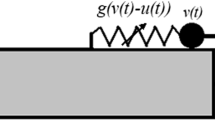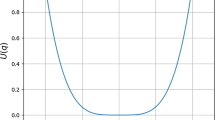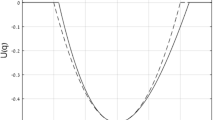Abstract
The paper considers a transient process of escape of a classical particle from a one-dimensional potential well. We address a particular model of the infinite-range potential well that allows independent adjustment of the well depth and of the frequency of small oscillations. The problem can be conveniently reformulated in terms of action-angle variables. Further averaging provides a nontrivial conservation law for the slow flow. Then, one can consider the problem in terms of averaged transient dynamics on primary 1:1 resonance manifold. This simplification allows efficient analytic exploration of the escape process. As a result, one obtains a theoretical prediction for minimal forcing amplitude required for the escape, as a function of the excitation frequency. This function exhibits a single sharp minimum for a certain intermediate frequency value, below the frequency of small free oscillations. This result conforms to earlier numeric and semi-analytic estimations for similar escape models, considered, in particular, in connection with problems of ship capsize and dynamic pull-in in microelectromechanical systems. The results presented in the paper allow conjecturing the generic dynamical mechanism, responsible for these regularities. In particular, the aforementioned sharp minimum in the frequency–amplitude domain is related to formation of heteroclinic connection between the saddle points on the resonance manifold. Numeric simulations are in complete qualitative and reasonable quantitative agreement with the theoretical predictions.







Similar content being viewed by others
References
Landau, L.D., Lifshitz, E.M.: Mechanics, 3rd edn. Butterworth-Heinemann, Oxford (1976)
Thompson, J.M.T.: Chaotic phenomena triggering the escape from a potential well. In: Szemplinska-Stupnicka, W., Troger, H. (eds.) Engineering Applications of Dynamics of Chaos, CISM Courses and Lectures, vol. 139, pp. 279–309. Springer, Berlin (1991)
Virgin, L.N.: Approximate criterion for capsize based on deterministic dynamics. Dyn. Stab. Syst. 4, 56–70 (1988)
Virgin, L.N., Plaut, R.H., Cheng, C.C.: Prediction of escape from a potential well under harmonic excitation. Int. J. Non-Linear Mech. 21, 357–365 (1992)
Sanjuan, M.A.F.: The effect of nonlinear damping on the universal escape oscillator. Int. J. Bifurc. Chaos 9, 735–744 (1999)
Mann, B.P.: Energy criterion for potential well escapes in a bistable magnetic pendulum. J. Sound Vib. 323, 864–876 (2009)
Barone, A., Paterno, G.: Physics and Applications of the Josephson Effect. Wiley, New York (1982)
Arnold, V.I., Kozlov, V.V., Neishtadt, A.I.: Mathematical Aspects of Classical and Celestial Mechanics. Springer, Berlin (2006)
Quinn, D.D.: Transition to escape in a system of coupled oscillators. Int. J. Non-Linear Mech. 32, 1193–1206 (1997)
Belenky, V.L., Sevastianov, N.B.: Stability and Safety of Ships—Risk of Capsizing, 2nd edn. The Society of Naval Architects and Marine Engineers, Jersey City, NJ (2007)
Younis, M.I., Abdel-Rahman, E.M., Nayfeh, A.: A reduced-order model for electrically actuated microbeam-based MEMS. J. Microelectromech. Syst. 12, 672–680 (2003)
Alsaleem, F.M., Younis, M.I., Ruzziconi, L.: An experimental and theoretical investigation of dynamic pull-in in MEMS resonators actuated electrostatically. J. Microelectromech. Syst. 19, 794–806 (2010)
Ruzziconi, L., Younis, M.I., Lenci, S.: An electrically actuated imperfect microbeam: dynamical integrity for interpreting and predicting the device response. Meccanica 48, 1761–1775 (2013)
Zhang, W.-M., Yan, H., Peng, Z.-K., Meng, G.: Electrostatic pull-in instability in MEMS/NEMS: a review. Sens. Actuators A Phys. 214, 187–218 (2014)
Benzi, R., Sutera, A., Vulpiani, A.: The mechanism of stochastic resonance. J. Phys. A Math. Gen. 14, L453–L457 (1981)
Gammaitoni, L., Hänggi, P., Jung, P., Marchesoni, F.: Stochastic resonance. Rev. Mod. Phys. 70, 223 (1998)
Manevitch, L.I.: New approach to beating phenomenon in coupled nonlinear oscillatory chains. Arch. Appl. Mech. 77, 301–312 (2007)
Manevitch, L.I., Gendelman, O.V.: Tractable Modes in Solid Mechanics. Springer, Berlin (2011)
Vakakis, A.F., Gendelman, O.V., Kerschen, G., Bergman, L.A., McFarland, D.M., Lee, Y.S.: Nonlinear Targeted Energy Transfer in Mechanical and Structural Systems, I and II. Springer, Berlin (2009)
Vakakis, A.F., Gendelman, O.V.: Energy pumping in nonlinear mechanical oscillators: part II—resonance capture. J. Appl. Mech. Trans. ASME 68, 42–48 (2001)
Hayashi, C.: Nonlinear Oscillations in Physical Systems. Princeton University Press, Princeton (2014)
Gendelman, O.V., Sapsis, T.P.: Energy exchange and localization in essentially nonlinear oscillatory systems: canonical formalism. ASME J. Appl. Mech. 84(1), 011009 (2017)
Kauderer, H.: Nichtlineare Mechanik. Springer, Berlin (1958)
Dimentberg, M.F., Bratus, A.S.: Bounded parametric control of random vibrations. Proc. R. Soc. Math. Phys. Eng. Sci. 456, 2351–2363 (2000)
Pilipchuk, V.N.: Transient mode localization in coupled strongly nonlinear exactly solvable oscillators. Nonlinear Dyn. 51, 245–258 (2008)
Pilipchuk, V.N.: Transitions from strongly to weakly-nonlinear dynamics in a class of exactly solvable oscillators, and nonlinear beat phenomena. Nonlinear Dyn. 52, 263–276 (2008)
Zaslavsky, G.M.: The Physics of Chaos in Hamiltonian Systems. Imperial College Press, London (2007)
Percival, I., Richards, D.: Introduction to Dynamics. Cambridge University Press, Cambridge (1987)
Manevitch, L.I.: A concept of limiting phase trajectories and description of highly non-stationary resonance processes. Appl. Math. Sci. 9, 4269–4289 (2014)
Kovaleva, A., Manevitch, L.I.: Autoresonance versus localization in weakly coupled oscillators. Physica D 320, 1–8 (2016)
Neishtadt, A.I., Vasiliev, A.A.: Change of the adiabatic invariant at a separatrix in a volume-preserving 3D system. Nonlinearity 12, 303–320 (1999)
Neishtadt, A.I.: Probability phenomena due to separatrix crossing. Chaos 1, 42–48 (1999)
Acknowledgements
The author is very grateful to Israel Science Foundation (Grant 838/13) for financial support.
Author information
Authors and Affiliations
Corresponding author
Appendix
Appendix
This appendix presents the derivation details for expressions (12) and (14). In accordance with definition (3), the action variable is expressed as follows:
The last integral is easily evaluated with standard methods of contour integration. Inversion of (A1) yields the expression for \(H_0 (I)\) from (12). Expression for the coordinate is calculated as follows:
Then, we obtain the second expression of (12), with insignificant change of sign. By symmetry considerations, Expression (12) for \(q(I,\theta )\) can be expanded in sine-Fourier series:
From (8) it is obvious that it is necessary to compute only the coefficient \(a_1\). One obtains:
Here \(c=\frac{\sqrt{2I-I^{2}}}{1-I}\), and, consequently, \(k=\sqrt{2I-I^{2}}\), as stated above. Substituting (A3–A4) into (5) and (8), one obtains \(q_1 =-\frac{ia_1 }{2}\) and then—expression (13). Further coefficients \(a_m ,m>1\) also are combinations of rational functions and complete elliptic integrals, but become quite awkward even for small m.
Rights and permissions
About this article
Cite this article
Gendelman, O.V. Escape of a harmonically forced particle from an infinite-range potential well: a transient resonance. Nonlinear Dyn 93, 79–88 (2018). https://doi.org/10.1007/s11071-017-3801-x
Received:
Accepted:
Published:
Issue Date:
DOI: https://doi.org/10.1007/s11071-017-3801-x




